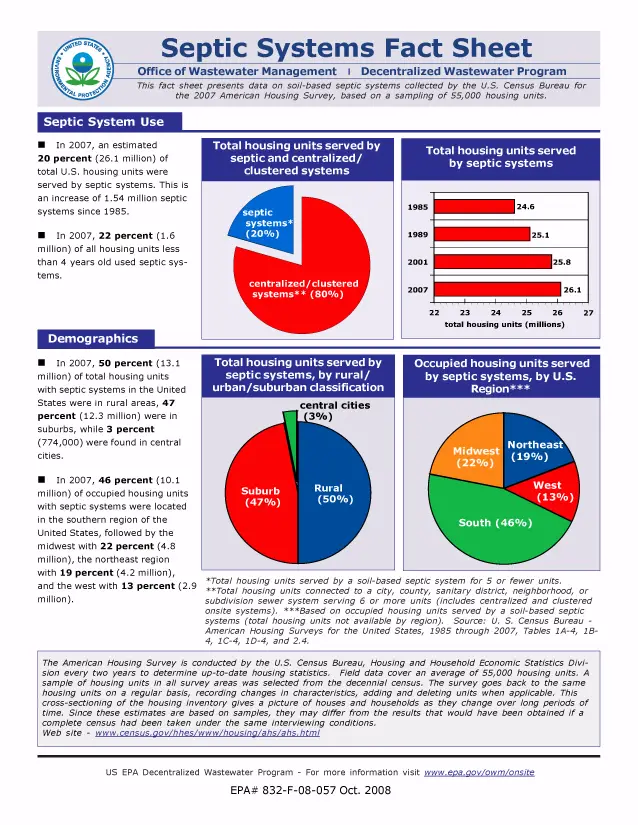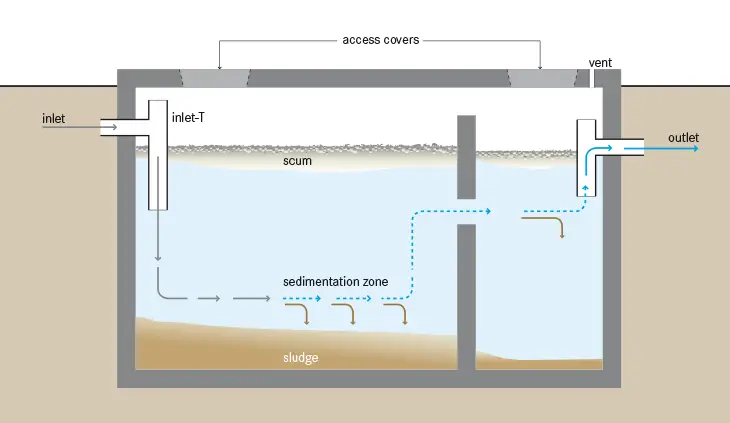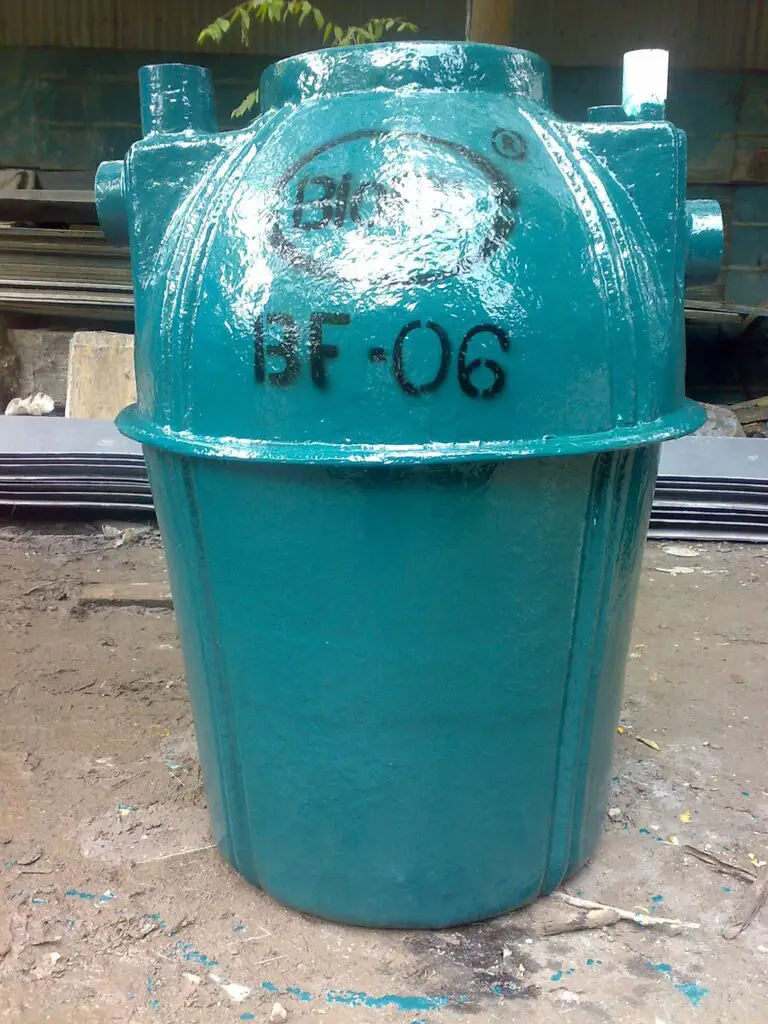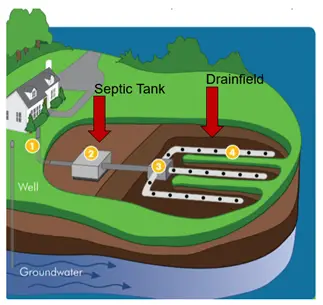One of the things folks forget about when owning a cottage or cabin in Northern Michigan is that they are likely proud owners of a septic tank system. It’s an icky subject, but it turns out it’s a critical item that cabin owners discuss and banter with each other at least once a year.
Everyone forgets about the backyard septic system until there is a smelly wet crisis bubbling up from below. This article will review how a septic system works, what to put in, and what to leave out, and finally, some practical hints about maintenance and repair of your septic tank and drain field.
How Many Families Use Septic Systems in the United States?

I was amazed to learn about the number of U.S. households that utilize a septic system. According to the U.S. Census, in 2007, over 26 million homes disposed of wastewater with an on-site disposal system such as a septic tank and absorption field. In states like Alaska, over a third of the population uses an on-site method. In North Carolina, 50% of the residents have a septic system. Overall, over 95% of homes with on-site water disposal systems use a septic tank.
It makes sense. In rural areas, homeowners must be able to be more self-sufficient. There simply aren’t the services available like that in an urban area. Installation of groundwater wells, backup generators, and septic systems is the norm. Waste disposal of trash and wastewater is one of the primary concerns for rural homes, cottages, and cabins.
Urban owners with second homes may own a septic system too. The 2010 U.S. census, reports that Michigan had over 235,000 homes denoted as secondary. Thus the seasonal cottage or cabin must use a septic system too.
How a Septic System Works
A Septic System has two major components; a septic tank and a drainage field. The septic tank consists of an impermeable airtight material like concrete, plastic, or fiberglass. The tanks were buried underground and inlined with the wastewater outlet of the home.

Septic tanks are waste processors. To ensure a positive flow pattern, all septic tanks should have baffles consisting of internal slabs or tees at the inlet and outlet. Most septic tanks have a single compartment, but some states in the U.S. require two tanks or enclosures to ensure solids are not flowing out to the absorption field.
The Size of Your Septic Tank

The typical home septic tank can hold 1,000 gallons of wastewater. The tank size can vary depending on the size of the home and state and local requirements. The tank’s sole purpose is to separate the solids from the wastewater and promote the breakdown of solid waste by bacteria and microbes. Sludge forms and sinks to the bottom of the tank; likewise, a foamy scum will rise to the surface. Both signal that the septic tank is working. The sludge is pumped out regularly by licensed septic haulers.
The Absorption and Drain Field

The wastewater is passed to the drain field with a connecting pipe. This drain field can also be called the soil drain field, absorption field, disposal field, or leach field. The closed-loop system is a series of underground pipes with small holes allowing the wastewater to drain into the soil slowly.
The wastewater coming from the septic tank to the drain field is cloudy, gray, and contains many disease-causing microbes and pollutants.
The drain field is typically placed in a dry, unsaturated area. The wastewater flows through the pipes and exits from the small perforations into a series of gravel and sand layers. As the effluent enters and flows through the soil, many of the bacteria that can cause illness are filtered out. Likewise, other germs and viruses are filtered and held by the sand and dirt until they die. The soil can retain some nutrients such as phosphorus and nitrogen. It’s not upcoming to see grass and other vegetation near a septic drain field green and thriving.
The soils treat the wastewater with a natural oxygenated and filtering digestion process and remove the remaining waste. Eventually, the water, now free of impurities, returns to the groundwater.
Use of a Small Crock for Dishwasher and Washing Machines
Some localities have a requirement to install a separate system for the intake of washing machine wastewater. This smaller tank allows detergents and bleaches to dissipate before flowing into the main septic tank. These harsh chemicals can kill the good microbes needed in the septic tank to break down waste solids.
Managing an Older Septic System
Those in northern Michigan who have bought or inherited an older home, cottage, or cabin have a unique challenge. Managing an older septic tank and field. Simple questions such as where are the tank access?; prove a daunting task. We found a great article for those with older systems; Learning to be SepticSmart, but what was with Ralph’s compass?
What is OK to Put Into A Septic System – Septic System Additives
OK – Septic systems can take in all wastewater from your home, cabin, or cottage, including all drainage from baths, sinks, showers, toilets, dishwashers, and washing machines. Any of these wastewaters left untreated would pollute area lakes, streams, and even groundwater.
NOT OK – Keep roof drains, basement sump pumps, and other surface water or rainwater away from the septic and drainage field. Excessive surface water in the absorption field will keep the soil from absorbing the wastewater. This will result in untreated run-off contaminated water on the surface.
NOT OK – Avoid using caustic drain openers for a clogged drain. Consider using boiling water or a drain snake for clogs.
NOT OK – Avoid highly caustic or acidic bathroom and kitchen cleaners. Be sure to look for cleansers that are Septic Safe or use a mild detergent and baking soda.
MAYBE OK – Check with your local zoning or state agency about the use of garbage disposal in your septic system. Check with your septic service provider about installing a garbage disposal and if your septic tank can handle it.
NOT OK – Never dump chemicals or solvents into drains served by a septic system. Do not drain grease, plastics, latex paint, pesticides, solvents, oven cleaners, degreasers, and solvents or any other hazardous fluids into your septic system.
Best Toilet Paper for Septic Systems
When purchasing toilet tissue, look for “septic friendly” on the package. Being septic friendly means it will dissolve promptly and not clog your septic system.
The best toilet tissue to use should be septic safe, biodegradable, and not require excessive sheets to use. If you live in an area where septic systems are used, your local retail store will likely offer suitable toilet paper brands at various price points.
Products to Care for Your Septic System
With proper use and periodic maintenance, your septic system should last about 30 years. However, from time to time, a system can become overloaded due to house guests, parties, or other household activity.
There are treatments to aid in the breakdown of septic tank solids. These consist of good bacteria or enzymes that multiply to absorb and digest grease, paper, and other solid waste.
Bacteria Additives for Septic System Cleaning
Products containing active bacteria cultures. These are living microorganisms that live in a septic tank and are called anaerobic bacteria. These bacterial organisms live without air and are selected to revive the enzymes required to reduce solid waste. It works on the sludge and scum layers of your septic tank and even out into the absorption field.
Enzyme Additive for Septic Tank Cleaning
Some products contain enzymes for use in septic tank systems. Enzymes aid the natural bacteria in septic tanks by helping to break down organic solids. This results in smaller waste molecules, making it easier for the bacteria to digest the smaller solids. These are typically called septic tank boosters and in the form of a flushable packet or liquid.
Use Caution with Septic Tank Additives
Most additives are a combination of bacteria and enzymes. Watch out for additives containing formaldehyde, zinc sulfate, and quaternary ammonium. These products promise to control odor, but they can act as a biocide, killing the good bacteria in your system. Additives containing extensive amounts of hydrogen peroxide might not harm the system’s bacteria but could damage the drain field’s soil. Use additives sparingly, if at all.
Summary For Septic Tank Service
A septic system is a safe, effective, and economical way to handle home and cottage and cabin wastewater. Your septic system can last for decades with routine periodic maintenance and using care when disposing of waste material. In those rare instances where heavy use is expected, then simple products can be added to the system to assist in septic effectiveness.
Related Reading
- Great Lakes Pollution – Saginaw Bay Muck is Poop
- Scott Hocking – The Emergency Ark
- Hints for a Fun Day Trip to Cheeseburger in Caseville Festival
- Muskegon Solar Array Project a Possibility
- Canada Confirms Potential Nuclear Waste Site Near Lake Huron and Michigan

Discover more from Thumbwind
Subscribe to get the latest posts sent to your email.




